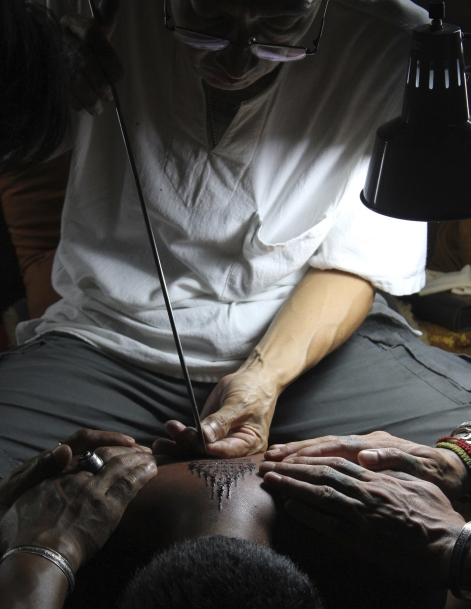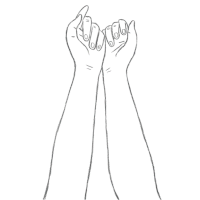
Sak Yant.
Every year, during the end of March, over 10,000 people flood the grounds of Wat Bang Phra, an ancient Buddhist temple about 50 kilometres west of Bangkok, famed for its history and magical tattoos. People enter the temple during the early hours of the morning to participate in a heady yet enriching festival revolving around the age-old art of Thai Tattoos – Sak Yant.
The participants come with the intention of recharging the magical powers coursing through the various tattoos that mark their skin, through a ceremony called the Wai Khru.
Wai Khru is a Thai ritual in which students pay respects to their teachers in order to express their gratitude and formalize the student–teacher relationship. The rituals of Wai Khru are believed to have derived from ancient animistic beliefs, influenced by the spread of Brahmanism from India.
What may sound sober takes a surprising turn as there’s a sudden crescendo of energy amongst those gathered. One after another, the devotees enter a state of trance and bliss, known as Khong Khuen (rise of the magical force), in which they jump, scream and charge headlong, arms flailing around, toward the front of the temple grounds where the monks sit and oversee the festival. The devotees become possessed by their Sak Yant, and embody their tattoos – tattoos that vary from tigers, crocodiles, mythical animals to various Hindu gods.
A phalanx of soldiers and paramedics guard the temple shrine from the onslaught of tattooed devotees, bringing them out of the trance by repeatedly rubbing their ears. As the festival concludes, the monks lead a prayer before the crowd rushes toward the stage to be blasted with holy water from a high-powered hose. The devotees leave, confident their tattoos have been sufficiently charged with magic again.



Photographs from http://www.expertvagabond.com
SAK YANT
Sak Yan or Sak Yant (Thai: สักยันต์), is a form of tattooing that originated amongst Thai people. These tattoos draw inspiration from Buddhist, Brahman, and animist imagery, and incorporate sacred geometry and magical incantations (kata) written in the Khmer version of Pali Sanskrit- also known as Khom. And they are believed to offer power, protection, fortune, charisma and other benefits for the bearer. Today it is practiced in Thailand and Myanmar, and to a much lesser extent in Laos and Cambodia.
Sak means “to tattoo” in Thai, and Yant is the Thai pronunciation for the Sanskrit word yantra, meaning ‘magical design’ or ‘mystical insignia’. Thus, the Sak Yant Tattoo literally translates to ‘Magical Tattoo’.
“Sak yant was influenced by the Khmer language since around 1,200 years ago. The language has no power in itself. But power comes from the [tattooing] ceremony.” Ajarn Neng Onnut, a renowned, Bangkok-based Sak Yant master who has tattooed Steven Segal and Brooke Shields, among other luminaries, told The Diplomat.
Sak yant designs are normally tattooed by ruesi (seers or sages), wicha (magic) practitioners, and Buddhist monks, traditionally with a long bamboo/metal rod sharpened to a point called the khem sak. Although today with many health concerns of the westerners obtaining their tattoos, many practitioners have modernized their methods and have begun using modern tattoo-guns in order to be completely safe.

ORIGIN & HISTORY
During the golden age of the Ayutthaya Kingdom (1351-1767 CE), warriors took to the battlefield clad in suea yant, or shirts covered in yant designs meant to protect them. Officials and civil servants from the period also wore sak yant on their shirts to signal their status and military level. Buddhist monks originally engraved Sak Yant into warriors seeking protection and strength in battle; often covering their entire bodies from head to toe in magic symbols to prevent knives and arrows from piecing their skin. Slowly, over a period of time, these designs travelled on to the bodies of the warriors themselves, when they realized inking the skin was a more practical idea. And thus grew the sacred art of Sak Yant Tattoos.
THE MONK AND THE AJARN.
The term ‘Ajarn’ is used to describe a learned person… similar to the term Professor or Master. When we refer to the term ‘Ajarn’ we are referring to a Sak Yant Master. Generally an Ajarn (or Sak Yant Master), is a former Monk who has taken his training in the Magical Art of Sak Yant and continued to provide the service to people even after they no longer work within the Temple environment.
The Traditional Sak Yant Tattoo is a magical and spiritual symbol that is done in an ancient language that takes Monks years to learn. A Tattoo Artist might be able to copy a pattern and give you a beautiful Tattoo – one that might look a lot more symmetrical and intricate – but the Monks and Ajarns change the text of the language to empower the Sak Yant and provide a magical blessing based on the purpose and intent behind the chosen design. Besides, getting a Sak Yant from a regular tattoo artist beats the whole purpose, doesn’t it?
Research into the culture and tradition of Thailand would lead one to believe that Buddhist monks do not tattoo on women. But this is one huge misunderstanding. In fact, Angelina Jolie broke all rumours and helped spread awareness about this sacred practice when she got her Sak Yant tattoo in 2004. Most people tend to confuse tradition and culture with the actual Vinaya ( Monk Code of Conduct). Thai Buddhist Monks are permitted to touch a woman, so long that it does not create lust. For this reason many Monks decide that it is better to be safer than sorry in this regards, and if they do touch a female they use prayer clothe (or gloves for Sak Yant) as an added layer.

THE PROCESS
Sak Yant is not like any ordinary tattoo. The application involves either a long metal rod or bamboo stick, which is used to insert the ink deep into the skin through a process called ink tapping. The ink (usually a clay mixture) is infused with various herbs, such as antiseptic waan root, wild ginger, sesame oil, snake venom, and, according to some travel witers, human remains as well. Apparently this adds power to the ink.
To know more about the practice and to watch Ajarn Ohr practice the sacred design, click here.
YANT DESIGNS
There are many traditional types and designs of yantra tattoos, but each design has it’s own meaning and intention, and demands to be placed in specific positions of the body in order for them to be effective. In Southeast Asian culture, the head is the most sacred part of the body. The further down the body, the less sacred, and foreigners with religious figures inked on their legs have caused upset. So, if you’re planning to get a sacred/religious tattoo, make sure you get it done in the right place!
Some of the most popular designs include:

‘Ongk Pra’ is a simple Buddha Yantra used both as an individual blessing and also as an embellishment to other, larger Sacred Yant designs. Commonly seen as 9 small Buddhas sitting on the nine spires of the Gao Yord Sak yant tattoo.

Yant Mahaniyom is also known as the great Preference Yantra – this is because of the fact that is posesses the powert of Metta Mahaniyom. Traditionally, yant Mahaniyom is generally Tattooed placed on the right shoulder on the back, instil a general air of completion, wholeness and balance.

Yant Gao Yord is the Yant Kroo of many of the Great Samnak Sak Yant around Thailand and South East Asia, and is perhaps the most well-known of all Sak Yant designs. They are many different versions of Yant Gao Yord, the most common being formed as a pyramid like structure, but some can also be formed in a flat alignment.

Yant Gao Yord being tattooed onto the back of a devotee.

Yant Suea Koo : The two tigers represent “Amnaj” (power over one’s subordinates), and is often used by Soldiers and Policemen in commanding positions.

Yant Paed Tidt is representative of the 8 directions of the Universe and has a kata to protect you in each direction you may travel in.

Yant Paed Tidt with a tiger in the centre.
SAK YANT AFTERCARE
Generally a Sak Yant does not bleed during the process because the steel needles that the monks and Ajarns use today, do not penetrate the skin as deeply as a tattoo machine. Your Sak Yant will heal much faster (usually a day or two) but it is a tattoo and to ensure long term quality, it is essential to provide an aftercare program.
After you receive your Sak Yant, you need to do the same things as you would a normal tattoo to avoid tattoo bleed (fuzzy lines if ink spreads) and to keep the ink dark after the healing scabs come off. Like any tattoo after a week the skin around the tattoo will start to flake off revealing the final and permanent Sak Yant.
So, if you don’t have a tattoo yet, and you’re waiting for your first one to be something special, plan a trip to Thailand maybe?
Yours truly,
The Blank Slate.




